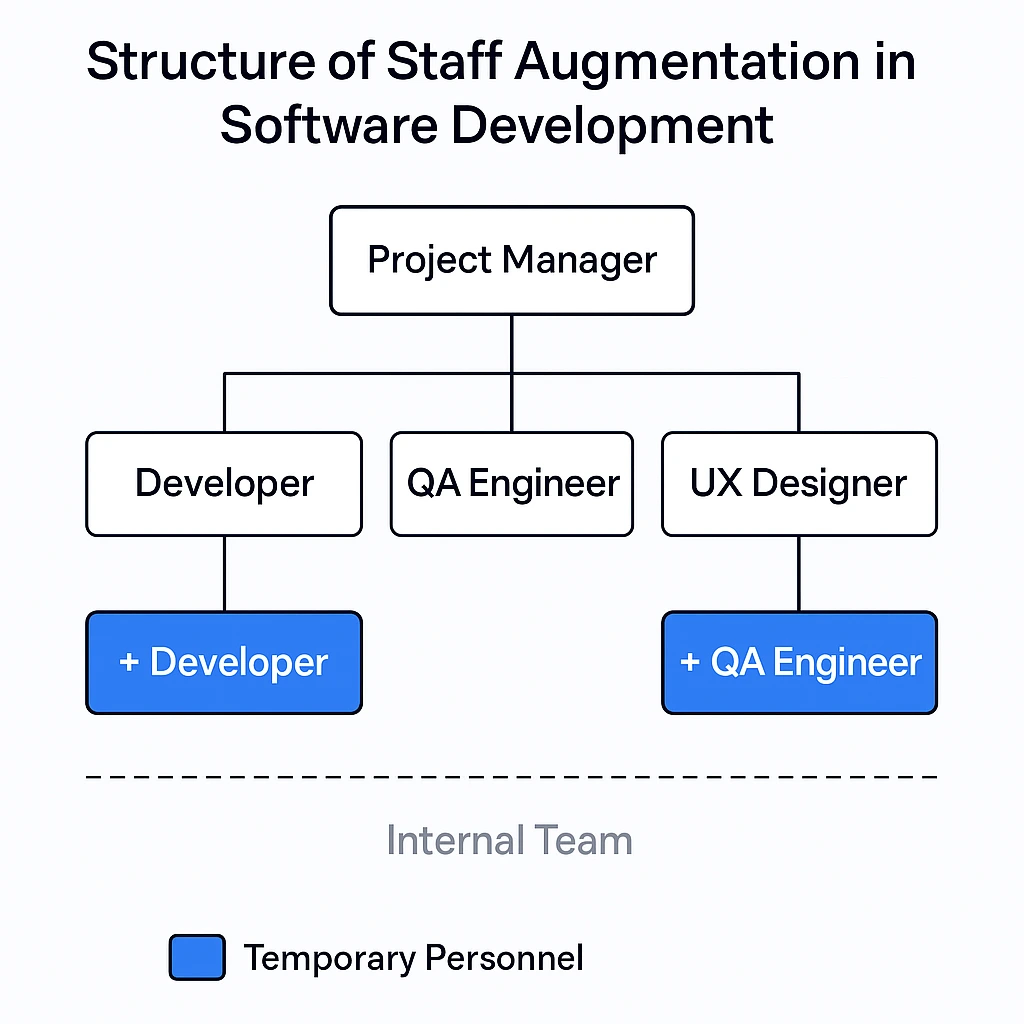As businesses evolve in today’s dynamic market environment, effectively scaling projects remains critical to achieving sustainable growth. IT Staff augmentation, an agile and strategic approach, allows organizations to expand their capabilities by temporarily integrating external specialists directly into their existing teams.
Given its flexibility, this model supports companies in quickly adapting to market changes without the long-term commitments and overheads.
Understanding IT Staff Augmentation
IT Staff augmentation involves hiring external professionals with specific expertise to supplement an organization’s existing workforce temporarily. Unlike conventional outsourcing, staff augmentation enables internal managers to retain direct oversight.

Example of Staff Augmentation Structure
Businesses typically leverage staff augmentation’s benefits approach to quickly address skills shortages, accommodate increased workloads, or accelerate project timelines without the long-term financial commitments of permanent hires.
Read more: Top IT Staff Augmentation Trends Shaping the Work Future in 2025
The Difference between IT Staff Augmentation, Dedicated Teams, and IT Outsourcing
| Dimension | IT Staff Augmentation | Dedicated Teams | IT Outsourcing |
| Team Composition | Individual specialists added to an existing team | A complete team with diverse roles (developers, QA, PMs, etc.) | Entire project or tasks delegated to an external vendor |
| Project Management | The client manages both the project and the augmented staff | The outsourcing provider manages the team; the client controls the project | Vendor oversees project execution and management |
| Cost Structure | Pay-as-you-go model; cost-effective for short-term needs | Higher initial cost but cost-effective for long-term projects | Typically follows a fixed-cost or milestone-based pricing model |
| Control & Oversight | The client retains full control over the augmented staff | Client controls project vision; provider manages day-to-day operations | Vendor assumes full responsibility for deliverables and outcomes |
| Scalability | Highly adaptable for short-term or fluctuating needs | Easily scalable as the project grows | Provides full project delegation with minimal internal involvement |
| Onboarding Time | Quick for individual resources | Longer initial setup but deeper long-term synergy | Rapid scaling with minimal internal setup |
| Ideal Duration | Short or medium-term projects requiring flexible resource allocation | Medium to long-term projects needing consistent, in-depth involvement | Suitable for both short-term tasks and long-term projects |
| Focus | Supplementing in-house capabilities | End-to-end project delivery | Delegating specific tasks or entire projects |
| Expertise & Responsibility | The client manages augmented specialists | Provider manages the team; client controls project direction | Vendor assumes full responsibility for project outcomes |
Key Points for Each Model:
- IT Staff Augmentation: Ideal for short-term projects requiring specific skills without long-term commitments. Offers flexibility and cost efficiency by integrating specialists into existing teams.
- Dedicated Teams: Best for complex, long-term projects that require consistent focus and team cohesion. Provides stability and seamless integration over extended periods.
- IT Outsourcing: Suitable for delegating entire projects or specific tasks to external vendors, ideal for situations where internal capacity is limited or specialized expertise is needed.
Key Benefits of IT Staff Augmentation for Project Scaling
When scaling projects, businesses must maintain agility and efficiency, and staff augmentation excels precisely here. Companies can achieve faster time-to-market, with augmented professionals seamlessly integrating into established workflows, reducing ramp-up periods significantly.
Moreover, staff augmentation provides exceptional scalability; organizations can quickly adjust the size and composition of their teams based on evolving project demands or seasonal fluctuations, making it an optimal strategy for short-term initiatives and sustained expansions. The immediate availability of specialized professionals also ensures enhanced productivity and improved quality outcomes right from the start.
Financial Advantages of IT Staff Augmentation
From a financial perspective, staff augmentation offers substantial savings compared to traditional hiring methods. Its pay-as-you-go structure allows businesses to optimize expenditures by paying only for the resources and services required at any given time. This model significantly reduces overhead expenses associated with permanent employment, such as benefits, training, recruitment costs, and office space. Consequently, organizations can allocate resources more efficiently, directly contributing to healthier project budgets and improved overall profitability.
Time and Resource Optimization
Staff augmentation notably reduces the lengthy hiring process that typically characterizes traditional recruitment methods, slashing timelines from months to mere weeks. By quickly integrating skilled professionals, businesses eliminate extensive interviewing, onboarding, and training periods, freeing internal teams to focus more strategically on core business activities. Additionally, distributing workloads through augmentation helps mitigate internal burnout and stress, fostering a more productive and balanced work environment.
Access to Specialized Talent
In the context of rapidly evolving technological landscapes, accessing specialized talent quickly can mean the difference between market leadership and obsolescence. Staff augmentation empowers businesses by providing immediate access to professionals with niche skill sets that may be difficult or impossible to source locally.
Leveraging global talent pools, companies overcome geographical and resource limitations, ensuring their projects benefit from cutting-edge expertise and practices, ultimately establishing a strong competitive advantage.
Step-by-Step Implementation Process
To successfully utilize IT staff augmentation, organizations should follow a structured process:
- Conduct a detailed needs assessment to identify skill gaps and define required roles.
- Select an augmentation provider with proven expertise, relevant industry experience, and a solid reliability record. They should have a proven track record of HR expertise and consulting management to take care of the whole process for you.
- Clearly establish roles, expectations, and measurable KPIs for accountability and transparency.
- Implement an effective onboarding process to seamlessly integrate augmented staff into existing workflows.
- Regularly perform performance reviews and adjust team composition based on project needs and outcomes.
Best Practices for Maximizing IT Staff Augmentation Success
Clearly Define Objectives
Thoroughly clarify your project’s goals, timelines, and the specific skills required before engaging augmented staff. Clear definitions set a firm foundation for team alignment and effectiveness.
Select the Right Partner
Choose an IT staff augmentation partner whose expertise, values, and culture align closely with your business. A well-matched partner significantly enhances integration, communication, and overall productivity.
You can do your research by using an AI search engine like Perplexity or Bing Copilot. Using this prompt: Find for me Top [service specification like cybersecurity, accounting] Staff Augmentation service providers in [location]. My budget is [your budget].
Browsing tech directories such as Clutch, GoodFirms, or TechBehemoth is also a good idea. You can read the reviews, testimonials, and portfolios before making a decision. You should leave some time for this step, as finding the right fit is a matter of your long-term investment.

Our staff augmentation checklist will be a great head start, helping you stay on track in finding a reliable tech partner.
Foster Seamless Integration
Establish comprehensive onboarding processes and provide necessary training and tools for augmented staff. Effective integration ensures smooth transitions and maintains high team productivity. The onboarding process needs to be optimized from the beginning so that your team or staff can get into work productively and align with your business’s objectives ASAP.
Build Hybrid Teams
Combine internal and augmented professionals into cohesive teams, leveraging diverse expertise and perspectives. Hybrid teams foster collaboration, enhance innovative thinking, and improve project outcomes.
Embrace Agile Methodologies
Implement agile practices to improve responsiveness, adaptability, and ongoing communication. Agile frameworks facilitate rapid adjustments and continuous feedback, which are crucial for project success.
Explore How to Successfully Onboard a Dedicated Team for Inspiration
Continuous Monitoring and Feedback
Regularly evaluate performance, offer constructive feedback, and implement improvements. Continuous monitoring sustains high performance and ensures ongoing alignment with business objectives.
Staff augmentation emerges as a strategic and authoritative solution for businesses aiming to scale projects effectively in today’s competitive market. By enabling the rapid deployment of specialized talent, IT staff augmentation helps companies achieve sustained growth and a competitive edge.
Want to strategically scale your projects with tailor-made IT staff augmentation? We’re here to deliver not the best but the most suitable solutions to your business needs. Contact us now
Frequently Asked Questions
Staff augmentation is a strategic approach that involves temporarily integrating external specialists with specific expertise into an organization’s existing teams to expand capabilities, address skills shortages, accommodate increased workloads, or accelerate project timelines.
Unlike traditional outsourcing where project control often rests with an external vendor, staff augmentation allows internal managers to retain direct oversight of the augmented staff. Dedicated teams involve hiring a complete external team, while staff augmentation focuses on individual specialists. Staff augmentation offers more client control and is ideal for short-to-medium-term needs, whereas dedicated teams are better for long-term, complex projects, and IT outsourcing delegates entire projects or tasks to a vendor.
Staff augmentation offers several key benefits, including faster time-to-market, exceptional scalability to adjust team size based on demands, enhanced productivity due to immediate availability of specialized professionals, and improved quality outcomes.
Financially, staff augmentation is cost-effective due to its pay-as-you-go structure, which minimizes overhead expenses associated with permanent employment such as benefits, training, recruitment costs, and office space. This allows for more efficient resource allocation and improved profitability.
The process includes conducting a detailed needs assessment, selecting a reliable augmentation provider, clearly establishing roles and KPIs, implementing an effective onboarding process, and regularly performing performance reviews.
Best practices include clearly defining project objectives, selecting the right partner whose values align with your business, fostering seamless integration through comprehensive onboarding, building hybrid teams, embracing agile methodologies, and conducting continuous monitoring and feedback.


